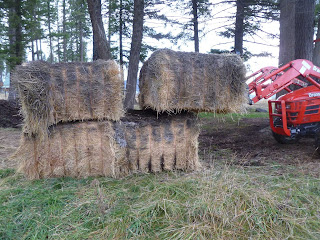If you remember, we had temporarily tarped our winter's supply of hay in early September. Now it was time to get that hay into the security of the barn. Hay stores best if it's tucked in a barn because a tarp, no matter how good, tends to collect moisture underneath it, resulting in mold and rot. But when hay is stacked in a barn, it stays bone-dry.
First thing we had to do was clean out and make room in the barn. You know how it goes... over the summer, things sorta collect. We left the remains of last year's hay in place. The nutritional value might be less, but it's neatly stacked and we didn't feel like moving it. By the time we get down to where we're using these bales (early spring), the animals will be supplementing with fresh grass anyway.
When we untarped the hay, we were delighted to find this row was perfectly dry. This stack had our newer tarp on it.
We weren't so lucky with the other row. The top bales got pretty rotten. Ah well, that's what happens with an older tarp...
The end bales and most of the bales on the bottom are salvageable.
To move the bales into the barn, once more we borrowed a tractor from some saintly friends. The reason is because our tractor doesn't have the ooomph to pick up bales and move them. Our friends' spiffy new tractor does. It slices! It dices! But wait, there's more! It picks up bales with ease!
As Don brought the first bale into the barn, Matilda was waiting for him. All right, fresh hay!
Guess she was hungry. And opportunistic.
We put the hay on pallets. The reason for this is during heavy rain, water will sometimes overflow from the driveway into the barn. The best possible way to keep hay from rotting - duh - is to keep it from getting wet.
Don admits newer tractors have some distinct advantages over older ones.
Within a fairly short period of time, the barn was looking very nice indeed.
The chickens, of course, thought we were doing all this for their own personal benefit.
Almost full...
Meanwhile, Don took the rotten-but-salvageable bales and stacked them outside near the feedboxes. We've been feeding the beasties off these for the last couple of days. Lots of rot, but lots of good stuff too. Waste not want not!
Last bale!
Thank you Mike and Judy for the loan of your tractor! It made a BIG task much easier.




















Hay is a neverending chore with livestock. We buy ten roundbales at a time. We used to tarp them, but had the same problem you had with moisture collecting underneath. We're feeding horses, not cows, and they don't have the double stomachs, so cannot tolerate moldy hay at all. If a bale is moldy, we have to burn it ...like burning money. We feed two bales a month in the winter and have found that by not tarping, the bales keep fine for the 3-4 months it takes for us to feed them out. We also buy 50 or so small square bales once a year to keep in the garage (alas, no barn ...yet!) for those times the weather won't allow us to move a new round bale out. At least the hay prices are down a bit this year. But hay is sure a big slice of the budget pie!
ReplyDeleteDrools,I wants that tractor.Wonder if Santa can bring me one ;)
ReplyDeleteI've never seen square bales that size! They stack nicely with a tractor, but how do you move them without one? We use small square bales and big round bales. I can at least roll one if the tractor's not running. Looks beautiful, though.
ReplyDeleteGracie Wray